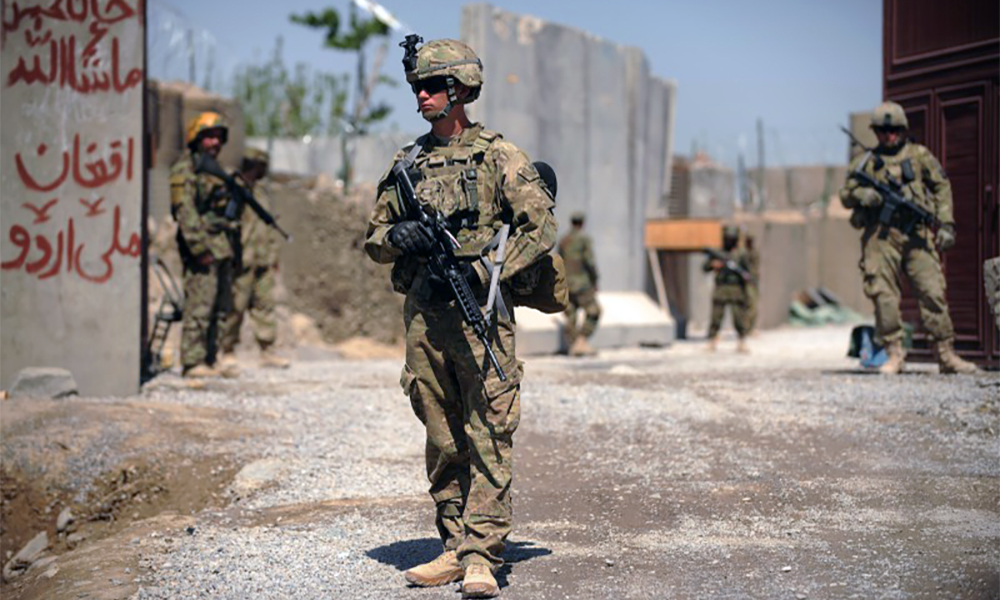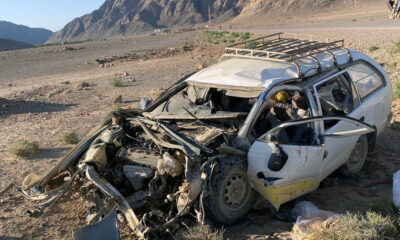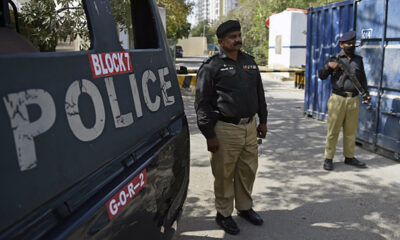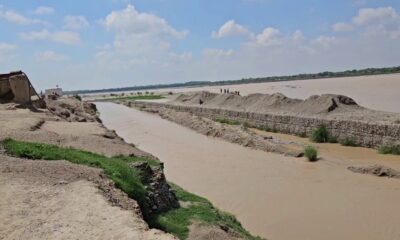Latest News
Hundreds of billions of US dollars “wasted” in Afghanistan

A catalog of “waste, fraud and abuse” reports made against the United States’ reconstruction efforts in Afghanistan have been “temporarily” removed from the Special Inspector General for Afghanistan Reconstruction’s (SIGAR) website.
In an expose by CNN, a US State Department spokesperson told CNN they had asked SIGAR to “temporarily” remove the reports, owing “to safety and security concerns regarding our ongoing evacuation efforts.” The spokesperson added SIGAR had the authority to restore them “when it deems appropriate.”
These reports, published for years on a quarterly basis, gave insight into the abuse and wastage of funds provided by the US government over 20 years.
The in-depth audits detailing these findings have, for the most part, been taken offline, despite having been widely promoted on social media platforms almost weekly for the past few years.
The total cost of the war, according to the Pentagon, was $825 billion, a low-end estimate: even President Joe Biden has cited an estimate that put the amount at over double that — more than $2 trillion, a figure that factors in long-term costs such as veterans’ care. The interest on the debt runs into hundreds of billions already, CNN reported.
However, the $145 billion reconstruction effort lacked oversight, leading Congress to set up SIGAR in 2008.
In their expose, CNN detailed 10 notable cases, stripped of identifying details on SIGAR’s website. The reports had however been collated by CNN over the years.
The cases are as follows:
1) The Tarakhil power plant project that was commissioned in 2007 as a backup generator for the capital, in case electricity supply from Uzbekistan was compromised.
A vast, modern structure, it ran on diesel-fueled turbines, supplied by a brand-name engineering giant. There was one catch: Afghanistan had scant diesel supply of its own and had to ship the fuel in by truck — making the plant too expensive to run, CNN reported.
The facility itself cost $335 million to build, and had an estimated annual fuel cost of $245 million. The most recent SIGAR assessment said at best it was used at just 2.2% capacity, as the Afghan government could not afford the fuel. USAID declined to comment.
2) A half-billion-dollar fleet of cargo planes that flew for a year ended up being sold as scrap.
In 2008, Afghanistan’s fledgling air force needed cargo planes and the Pentagon chose the G222 — an Italian-designed aircraft designed to take off and land on rough runways.
That first year, according to a speech made by SIGAR’s chief John Sopko, citing a USAF officer, the planes were very busy.
But they would not be sustainable. The aircraft were only noticed by SIGAR when Sopko noticed them parked at Kabul airport and asked what they were doing there.
Six years after the procurement was launched, the 16 aircraft delivered to Afghanistan were sold for scrap for $40,257. The cost of the project totaled $549 million.
3) A $36 million Marines HQ in the desert was neither wanted nor used, Sopko said in a speech, but this 64,000-square foot control center in Helmand cost $36 million to build in 2010 and was never used. Sopko recalled the base commander and two other marine generals said it was not needed as it would not be completed fast enough but said the thought of returning the funds to Congress “was so abhorrent to the contracting command, it was built anyway. The facility was never occupied, Camp Leatherneck was turned over to the Afghans, who abandoned it.”
4) In 2007, $28 million was spent on a new camouflage pattern for army uniforms for the Afghans. A total of 1.3 million sets were ordered costing $43 to $80 each, as opposed to $25 to $30 originally estimated for replacement uniforms.
The uniforms were never tested or evaluated in the field, and Sopko said it cost taxpayers an extra $28 million to buy the uniforms with a patented pattern.
SIGAR projected in 2017 a different choice of pattern could have saved a potential $72 million over the next decade.
5) The US spent $1.5 million a day on counter-narcotics programs (from 2002 to 2018). Opium production was, according to the last SIGAR report, up in 2020 by 37% compared to the year before. This was the third-highest yield since records began in 1994.
In 2017, production was four times what it was in 2002. A State department spokesperson noted “the Taliban (IEA) have been the primary factor contributing to poppy’s persistence in recent years” and “that the Taliban (IEA) have committed to banning narcotics.”
6) An extensive ring road around Afghanistan was funded by multiple grants and donors, totaling billions during the course of the war. Towards the end of the project, a 233-kilometer section in the North, between the towns of Qeysar and Laman, led to $249 million being handed out to contractors, but only 15% of the road was being built, a SIGAR audit reported.
Between March 2014 and September 2017, there was no construction on this section, and what had been built deteriorated, the report concluded. USAID declined to comment.
7) An extensive hotel and apartment complex was commissioned next to the US Embassy in Kabul, for which the US government provided $85 million in loans.
In 2016, SIGAR concluded “the $85 million in loans is gone, the buildings were never completed and are uninhabitable, and the U.S. Embassy was forced to provide security for the site at additional cost to U.S. taxpayers.”
The audit concluded the contractor made unrealistic promises to secure the loans, and that the branch of the US government who oversaw the project never visited the site, and neither did the company they later hired to oversee the project. A State department spokesperson said they did not manage the construction and it was “a private endeavor.”
8) The Pentagon created the Task Force for Business and Stability Operations (TFBSO) expanded from Iraq to include Afghanistan in 2009, for whose operations in Afghanistan Congress set aside $823 million.
Over half the money actually spent by TFBSO — $359 million of $675 million — was “spent on indirect and support costs, not directly on projects in Afghanistan,” SIGAR concluded in an audit.
They reviewed 89 of the contracts TFBSO made, and found “seven contracts worth $35.1 million were awarded to firms employing former TFBSO staff as senior executives.”
An audit also concluded that the fund spent about $6 million on supporting the cashmere industry, $43 million on a compressed natural gas station, and $150 million on high-end villas for its staff.
9) A 2015 report into USAID’s funding of healthcare facilities in Afghanistan said that over a third of the 510 projects they had been given coordinates for, did not exist in those locations. Thirteen were “not located in Afghanistan, with one located in the Mediterranean Sea.” Thirty “were located in a province different from the one USAID reported.”
And “189 showed no physical structure within 400 feet of the reported coordinates. Just under half of these locations showed no physical structure within a half mile of the reported coordinates.”
The audit said that USAID and the Afghan ministry of Public Health could only provide “oversight of these facilities [if they] know where they are.” USAID declined to comment.
10) At least $19 billion lost to “waste, fraud, abuse”
An October 2020 report presented a startling total for the war. Congress at the time had appropriated $134 billion since 2002 for reconstruction in Afghanistan.
SIGAR was able to review $63 billion of it — nearly half. They concluded $19 billion of that — almost a third — was “lost to waste, fraud, and abuse.”
DoD spokesman Lodewick told CNN they and “several other U.S. Government departments and agencies are already on record as having challenged some of these reports as inaccurate and misleading” and that their conclusions “appeared to overlook the difference between reconstruction efforts that may have been mismanaged willfully/negligently and those efforts that, at the time of the report, simply had fallen short of strategic goals.”
Latest News
IEA urges World Bank to resume work on 7,000 incomplete projects

Officials at the Ministry of Rural Rehabilitation and Development (MRRD) say 7,000 incomplete projects of the World Bank are at risk of destruction in Afghanistan. They call on the World Bank to resume the work of these projects.
According to them, discussions have been held with the World Bank about these projects, but there has been no result yet.
“7,000 incomplete projects are being destroyed, and if the work is not started, these projects will be destroyed. We ask the World Bank to resume the work of these projects as soon as possible,” said Noorul Hadi Adel, the spokesperson of MRRD.
Meanwhile, members of the private sector also ask international institutions to resume their work in Afghanistan.
According to the officials of this sector, with the start of these projects, job opportunities will be provided for thousands of people in the country.
“These projects create employment for our people and the country will grow a lot,” said Mirwais Hajizadeh, a member of the private sector.
However, economic experts stated if the work of these projects does not start soon, they will be destroyed and the investments made in them will be wasted.
Latest News
Ten people killed by floods in Helmand

Ten people have been killed and six others injured by floods in Helmand province in the past week, local officials said on Friday.
According to officials, seven of those were members of the same family, and they were killed in Kajaki district last night.
“Most of the people moved from vulnerable areas to high lands and mountains, and thanks Allah the number of casualties is low,” Sher Mohammad Vahdat, the head of information of the Directorate of Information and Culture in Helmand, said adding rescue teams and security forces have been dispatched to help people.
It is said that the telecommunication system has also been disrupted due to the effect of floods in Kajaki district. Floods have also destroyed thousands of acres of agricultural land.
Latest News
UN envoy meets Indian foreign minister to discuss Afghanistan

Roza Otunbayeva, the UN Secretary General’s Special Representative for Afghanistan, met with the Indian Foreign Minister Subrahmanyam Jaishankar in New Delhi and discussed issues related to Afghanistan, it was announced on Thursday.
During the meeting, Otunbayeva thanked India for “its critical humanitarian support and longstanding friendship for the Afghan people” and discussed the importance of regional and international cooperation to address prevailing challenges in Afghanistan, UNAMA said on X.
Jaishankar also said on X that the sides exchanged views on the current situation in Afghanistan.
“Underlined that India has provided wheat, medicines, pesticides and school supplies. Appreciate the role of UN agencies as partners in these endeavors,” he said.
-

 Sport4 days ago
Sport4 days agoACL fever grows as fixtures finalized
-

 World4 days ago
World4 days agoUS will not take part in any Israeli retaliatory action against Iran
-

 Latest News4 days ago
Latest News4 days agoOver 50 people dead in traffic accidents over Eid
-

 Latest News4 days ago
Latest News4 days agoUS identifies Kabul airport suicide bomber
-

 Latest News4 days ago
Latest News4 days agoGood rains enable DABS to increase power production in Kabul
-

 Business4 days ago
Business4 days agoAfghanistan-Kazakhstan chamber of commerce opens in Herat
-

 World3 days ago
World3 days agoIsraeli military vows response to Iran attack as calls for restraint mount
-

 Latest News3 days ago
Latest News3 days agoPakistani police give Afghans in Balochistan one day to leave
























